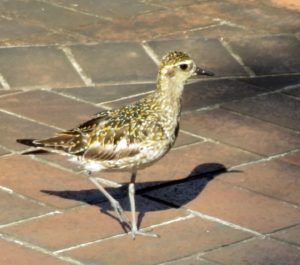
Photo courtesy of Sigrid Southworth. Punchbowl Cemetery, August 20, 2021.
August 26, 2021
“It makes me so happy to see them – helps me feel reassured that some aspect of life is a bit normal.”
This was the last sentence of an email I received from reader, Ana Gamble, regarding a bird she recently saw at the Kapalama Campus of Kamehameha Schools. Hawaii residents will know who “them” refers to in her message: our Kolea, of course.
Since July, Pacific Golden-Plovers, called Kolea here in the Islands, have been returning from their Alaska breeding grounds to Hawaii, a 3,000-mile nonstop journey the birds make in four days. The first sighting was July 14th in Kalaoa (near Kona International Airport) where Hawaii bird guide, Lance Tanino, reported seeing a Kolea in partial breeding plumage. (It’s not possible to determine a returning plover’s sex because the birds begin shedding their breeding feathers while sitting on their eggs.) Other Kolea watchers reported a total of 32 individuals in July. (Report your bird’s return at: www.koleacount.org)
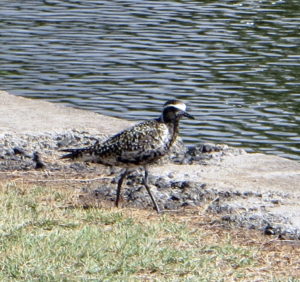
Photo courtesy of Ann Egleston. Waiʻalae Beach Park, August 18, 2021
Plover expert Wally Johnson writes that birds returning to Hawaii in July are adults that experienced one of two circumstances: 1) They had an outstanding breeding season, with chicks maturing so early that they no longer needed parental protection, or 2) They had a disastrous breeding season, in which the adults lost their chicks to predators or bad weather. Because both situations occur naturally, a few July returns of Kolea are normal.
Since August 1st, however, the birds have been delighting plover lovers statewide by increasingly returning to their established territories. The first ones back are usually females, followed by males on into September. Chicks arrive, and look for home territories, in October and November. If it survives its first winter, a young bird will come back to that site for life. Most Kolea live six-to-seven years, but the lucky ones can live for 20 or so years.

The yellow square above the runway marks the first Kolea Roger Kobayashi saw on Ford Island, August 11, 2021.
As of this posting, a total of 559 Kolea have been reported with more landing every hour of every day.
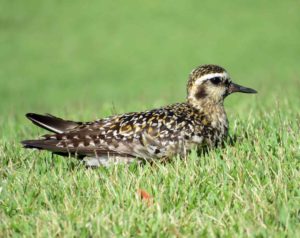
Photo by Sigrid Southworth. Punchbowl Cemetery, August 20, 2021
While walking in Kapiolani Park toward the Waikiki Shell to attend a Honolulu Symphony concert on August 7th, I saw my first plovers of the season. Before me stood four Kolea near one another, not foraging, but looking a bit stunned, as if they had just landed. The sight of them stopped me for a long moment as I appreciated all that those little birds have achieved this year. Those four birds standing there made me a little teary, their appearance as memorable as the concert.
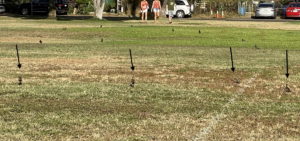
My four plovers in Kapiolani Park, August 7, 2021
A White Tern family, AKA Manu o Ku, gave me another teary moment this month. I was at Waikiki’s International Marketplace to meet a reporter from HPR’s “The Conversation” to talk about the terns that breed in the center’s famous Banyan tree. (To learn more about Honolulu’s special terns go to www.whiteterns.org)
I nicknamed the birds I routinely visit there the Lady Godiva family, because the parents courted, the female laid her egg, and the chick hatched on a low branch near the chocolate shop (now gone.)
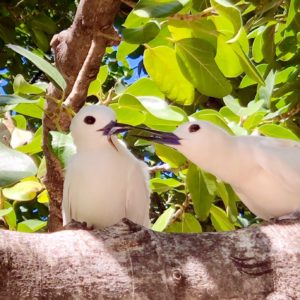
The Lady Godiva couple courting. While courting or reestablishing a bond, one tern often gives a fish to its mate. International Marketplace. ©Susan Scott
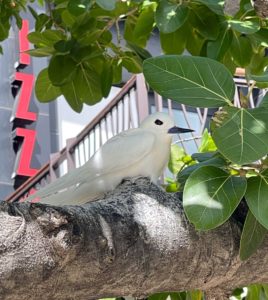
The Godiva female laid her egg in a scar on the tree branch. Parents take turns incubating their egg. ©Susan Scott
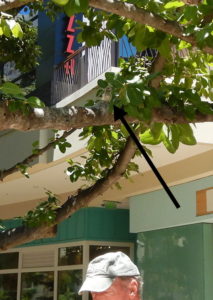
The endless passers-by below were oblivious to the Godiva chick above. ©Susan Scott
The couple’s chick was there alone in all its cuteness, and as I waited, a parent arrived with a fish to feed its baby. I raised my camera, snapped the feeding, and then caught the parent on camera dive bombing me. Back off! that bold little bird was saying to this giant intruder. The thrill of seeing this hardy, spirited seabird family in the middle of one of the most busy places in the Islands was another emotional moment for me.
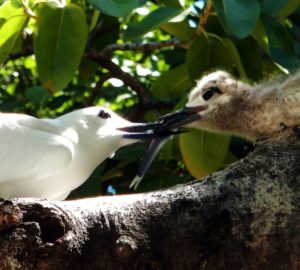
A parent returned from the ocean to feed the Godiva chick while I watched. ©Susan Scott
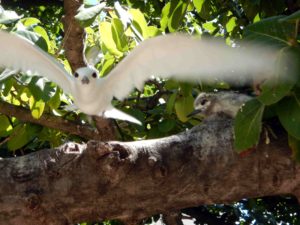
Annoyed by my clicking camera, the parent shooed me away with a close fly-by. ©Susan Scott
A third moving experience this month was welcoming my husband home from South Africa after finishing a three-month-long restoration project on the UK’s remote Gough (pronounced Goff) Island. (goughisland.com/the-project) The workers completed the spreading by four helicopters of 210 tons of mouse poison to save the 8 million seabirds that nest on Gough, the last breeding site of several species.
Gough Island may be on the opposite side of the planet, but the effort is relevant to Hawaii’s seabirds, because out-of-control numbers of mice are also eating Midway’s ground-nesting seabirds. Hawaii’s wildlife managers will use lessons learned from Gough for the Midway mouse project, scheduled for 2022.
Despite the changes in human life that Covid-19 has wrought, it’s heartwarming to see Hawaii’s shorebirds and seabirds go about their usual business of continuing their species. In their flying, feeding, breeding, and calling, these extraordinary native birds are cheery reminders that, as Ana reminds us, some parts of life remain normal.
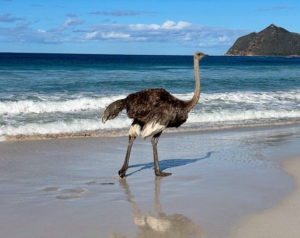
Craig shot this photo while waiting for his departing flight from Cape Town. It came with this note: “Here’s a new nonmigratory shorebird for you to count.” © Craig Thomas